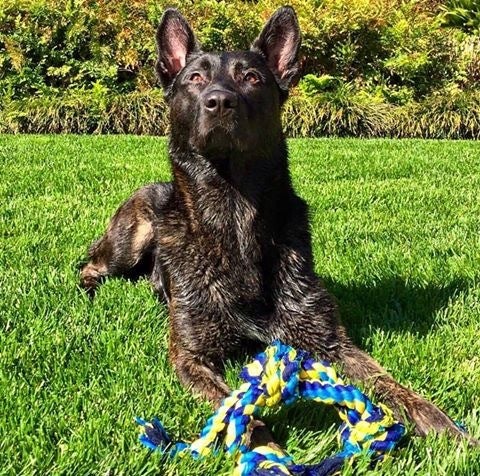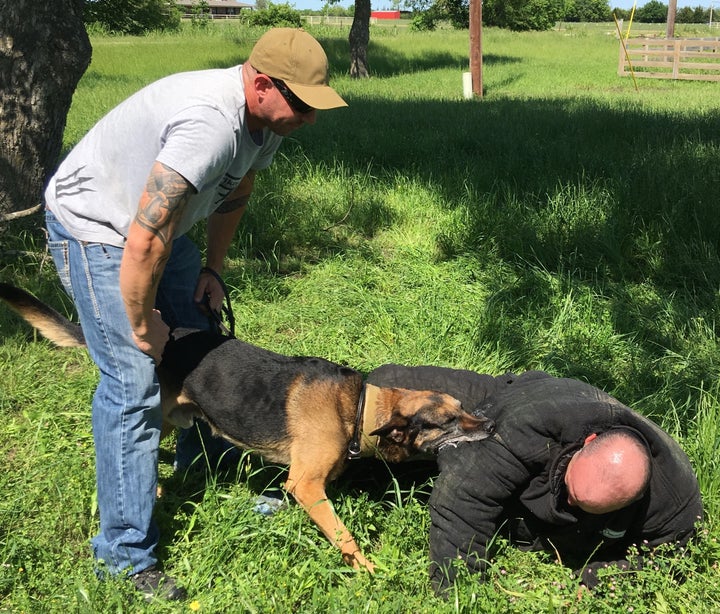
Mike Ritland is a former U.S. Navy SEAL, trident holder, and frogman. Ritland spent 12 years of active duty as a Navy SEAL, after that he became a BUD/s instructor, and opened up his own company to train K9’s for the SEAL Teams.
Ritland lives in Texas; has a ranch that’s a little over an hour drive, northeast of Dallas, and as the old proverb goes, “You don’t mess with Texas.” There’s not much emphasis in the word “retired” in Ritland’s world, soon after retiring from the SEAL’s he opened up his own company called Trikos International, then authored three New York Times Best selling books: Trident K9 Warriors, Navy SEAL Dogs, and TEAM Dog. He also opened Warrior Dog Foundation to offer a place for retired military working dogs.
He trains like he always has, he trains the best. Nowadays the “best” means training some of the most elite protection and working dogs in the world at Trikos International. Most of the time with a specific breed of dogs, called “Belgian Maliniois;” a favorite amongst military and police organizations in the USA.

At Trikos International, Ritland’s trained K-9’s for a whole host of different organizations such as the Department of Defense, TSA, Border Portal, and for individuals who want a personal protection dog. I spoke with Mike about some of the work he does with dogs.
What type of methods do you use to train a protection dog?

So basically there’s four quadrants of operant conditioning. That really no matter what kind of training you’re doing, you’re essentially following into one of those quadrants all of the time. Positive and negative punishment, positive and negative reinforcement; and what’s important is to think of the positive and negative. Not from a social stand point of good and bad, but algebraically or mathematically of you know, adding or subtracting. So people will say, “How can you positively punish a dog?”
What that means is you’re adding punishment, so positive punishment is adding, and negative punishment is taking it away. Reinforcement is that as well, you’re either reinforcing it with an award, or withholding or removing a award to get a desired behavior. So within the confines of that context: I would say 85% of the time we are in the positive reinforcement quadrant. So most of our training is done through positive reinforcement, in other words, when the dog does something that we want, it gets marked and rewarded, with some sort of reward. Now that can be throwing a ball, it can be administering a treat of some sort. Sometimes we will feed the dog that way, and do hundreds of repetitions of positive reinforcement and that’s how the dog gets fed throughout the day. You know, it can be affection; it can be the release of pressure. There’s a lot of different ways to go about it.
What kind of work goes into training a Navy Seal dog?
I mean it’s pretty extensive, I would say the parallels between what it takes to train a Navy Seal and train a Navy Seal dog are pretty comparable. Both in how stringent the selection process is, how adversarial, and difficult the training process is. Then ultimately what that final product is and how specialized and elite, and well trained it is, is also very similar. So almost every question that you would say, “You know, what does it take to do this with a dog?”
It’s almost always, “Well it’s about the same as it is with people.” The only exception is the selection process right out of the gate for dogs is much, much more stringent and what that boils down to is a time and money thing frankly. It’s that, you know, when we go and select dogs for the seal teams or any special operations group or even some of the higher end level federal law enforcement groups, the SRT (Special Reaction Team) groups and things of that nature.
The selection process is extremely difficult right out of the gate so that we’re not selecting dogs that we’re not very, very confident that are going to make it through the training pipeline.
In the wake of several terrorist attacks around the world, how important is it for law enforcement organizations to have access to K-9 Units?
Well, I think it’s imperative. Post 9-11has really has taught us, not only just recently, I mean every year or every couple of years you can look at some pretty significant events that have accord. You know obliviously, I don’t want to armchair quarter back and it’s easy to do that. But, you know, really in most of those cases you can pinpoint areas were if they’d had dogs and a protocol put in place to where people would have to go through dogs to get through certain areas.
And that’s really the rub, you know, you have to setup choke points, where you’re funneling people through areas where there is no way to get through and yes, it slows things down and whatever. But, you know, if you truly want to protect people, you’ve got to have dogs posted at certain areas and funnel everybody through there, where they have to get passed the dog to get into some of these secure areas. You do that and there is no way around it.
So, you know, and there is a lot of other uses for them as well. I mean just having them as a deterrent, having the apprehension capabilities is a huge bonus too. You know, there noses are a huge part of the equation. Their ability to track and chase people down, and apprehend people and neutralize threats is a huge bonus too. That they’re very effective and we use them non-stop in the special operations communities to do things like that.
You can find more info about Mike Ritland and Trikos International at: www.trikos.com
